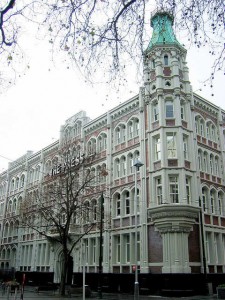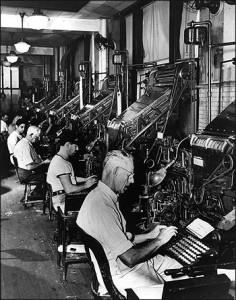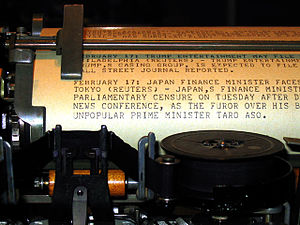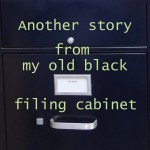Posts Tagged ‘earthquake’
Inside a 1960s newspaper office
In graduate seminar at the University of Canterbury, Professor Neville Phillips fixed me with a stern eye as he returned my latest effort. “You are getting through your history papers, Miss Dinsdale, on your writing style, not on your knowledge of history.” I flinched, and worried. Graduation was coming up, and I planned to apply for a job on The Press, Christchurch, New Zealand’s morning newspaper. Within the next week or two I needed to ask him for a letter of reference. Not only was Prof. Phillips head of the history department, he was a former newspaperman himself, and still had deep connections at The Press.
I needn’t have worried. Not only did he write me a nice reference, he also penned a personal note to the paper’s editor, Arthur Rolleston (Rollie) Cant, that opened the door to my dream job.

Press Building, Cathedral Square, Christchurch, NZ. Photo by Michael Whitehead from
http://www.nzine.co.nz/features/150years_the_press.html
I had known since childhood that writing was what I wanted to do. Movies about newspapers such as While the City Sleeps (1958), Deadline – U.S.A. (1952) and Ace in the Hole (1951) filled me with fantasies about the drama and excitement of the reporter’s life. Here was my chance to prove myself.
I loved working at The Press. A great Gothic pile on Cathedral Square, in the heart of Christchurch, the Press Building was a newspaper office out of one of those Hollywood movies: a cavernous newsroom that smelled of newsprint and dust, where telephones jangled, the chief reporter barked commands and the urgent clatter of the Teletype machine signaled a breaking story somewhere in the world.

Picture of Merganthaler linotype machines in a compositing room from the archives of the Nieman Foundation http://www.nieman.harvard.edu/
Sometimes I would be sent on an errand out back to the compositing room, a shadowy cave where enormous Mergenthaler Linotype machines made a deafening clatter. Deeper into the heart of the building, the throb and rumble of the great press itself, and the bustle of loading trucks in the small hours of the morning for long distance runs. When The Press celebrated its 100th anniversary in May 1961, its circulation was 62,000, with subscribers throughout the South Island.
It felt glamorous to work late into the evening, rushing back from meetings to meet the deadline for next morning’s paper. I shared dreams with the other young reporters, all of us with a few scratched notes tucked away for what each of us was sure would be the Great New Zealand Novel. We all had the sense of being part of an old tradition.
Among my notes I found this description of the office, written in 1960. Christchurch at that time was a sleepy provincial city of 193,000 people, and exciting news stories didn’t happen all that often.
I described the office as a jumbly assortment of rooms, all dirty and uncared for, and with space saving nonexistent.

I particularly appreciated my desk in the women’s department, by a window where I could gaze out across Cathedral Square. I’ve written about this view in an earlier post.
 Alas, the old Press Building is no more, a victim of the February 22, 2011 Christchurch earthquake, four years ago today. The staff now report the news from a new modern building nearby.
Alas, the old Press Building is no more, a victim of the February 22, 2011 Christchurch earthquake, four years ago today. The staff now report the news from a new modern building nearby.
Maureen is exploring the contents of an old black filing cabinet in her attic, which contains 55 years of her writing notes and memorabilia.
A Lifetime of Friendship
“I have not written these poems, nor even read them; this is a spoken book,” declares my friend Diana Neutze on the back cover of her latest collection, AGAINST ALL ODDS. The title refers not just to her illness—she has battled Multiple Sclerosis for well over forty years—but to the difficulties inherent in transforming poems from her mind to the printed page. As MS closed down her body, she progressed from longhand, to one finger on the computer, to voice recognition. “But now I dictate to Gabrielle, my editing carer. Even the editing has been done by voice, backwards and forwards in the air.”
I was privileged to receive a copy of this handsome limited edition. Written over the past three years, the poems chronicle the poet’s recognition that her death is imminent and her determination to live each remaining day in the beauty of the moment. The poems are rich with images such as: …a tangle of branches/ peremptory against a crystal sky. She asks:
If I died tomorrow, what would
happen to the poems in my head?
Christchurch, New Zealand, where Diana lives, has suffered a series of devastating earthquakes and aftershocks that figure in many of the poems. In “Elsewhere” she writes:
…the earth where I thought
to lay my final bones
is writhing like a wounded snake.
The earthquake draws her mind outward to share a communal grief:
I mourn for the lost, the mained, the dead.
I mourn for our grieving city.
The experience of working with composer Anthony Ritchie on a song sycle of her poems draws her to a new awareness of the importance of people in her life. The final poem in the book reworks “Goodbye,” the final poem in the song cycle. Keeping the opening lines: If this day were to be/ my last …, she traces the trajectory of her preparations for death, from spiritual and inward-looking to a recognition of a fear in which …I relegated/ my friends to the outer suburbs. The poem ends:
If tonight were to be my very last,
I would be desolate
at leaving behind
a lifetime of friends.
I have been friends with Diana since our freshman year at the University of Canterbury, fifty-four years ago, where we met in English Literature class. During school breaks we worked as kitchen hands at the same remote fishing camp. We lived next-door to each other as young marrieds, and shared survival tips as penniless expatriate parents of small children in London. Over the years and across the globe we have stayed in touch, supporting each other as best we could in times of grief, commenting on each other’s poems, occasionally visiting. I honor this lifetime of friendship as I read AGAINST ALL ODDS.
Christchurch Earthquake
As I grieve the earthquake destruction in Christchurch, New Zealand, I have been remembering my time as a reporter on The Press, Christchurch, New Zealand’s city newspaper. I worked afternoons and evenings. When no deadlines pressed, I would gaze out my window in the Press Building, which overlooks Cathedral Square. The Press Building is badly damaged, and the cathedral spire in the center of my view has toppled. Rummaging in old files, I found fragmentary notes typed on yellowed newsprint, the small sheets we used to turn in our stories. They are undated, but would have been written in 1960 or 1961.
###
From here, with the afternoon sun through the window, people walking the square are mere silhouettes, with long shadows reaching out towards me. I can sometimes pick out what they are wearing, but they are mostly a pattern of shapes, against the curved lines of the square that isn’t a square at all, but the shape of a cross, with gently sweeping curves of the cathedral grounds in the center. A pleasant curve below me, with its little stone wall, a comfortable height for sitting on. There was a woman sitting there, by the entrance with the knobs on it. She was wearing a cream coat and a bright pink hat. It was a cheerful hat, and now her escort has arrived, and she has walked across the road with him.
Lots of people jump over the wall—it is much more fun than going through the entrance with the knobs in the proper manner.
A little choirboy runs to a bicycle parked against one of the buttresses of the cathedral. He has been to sing Evensong. Now he is joined by two others, three, four—they pour out, shouting and jostling. Neat little grey suits and red caps, schoolbags swinging in the dust. Singing is just part of their everyday living, as much as football and schoolwork.
The right of way by the cathedral is patterned with people coming to and fro. It is the back-lighting at this time of evening that makes the scene so attractive. Sunlight through the plane trees by the war memorial, a golden outline on each figure, long patterns of light and shade.
Silhouettes—the big cross on the memorial, the slender cross on the top of the cathedral spire, the stark criss-cross of the scaffolding round the spire, wrapping it in a blanket while it is cleaned and whitened. The sunlight through the green glass of the tower windows, tall narrow windows with diamond patterns.
###
Delicate tracery of bare branches outlined with sunlight on a winter afternoon. Dew silently falling—streets slowly dampen, although the sky is cloudless. Towards the west, the setting sun fills the sky with smoky pink. Buildings are grey silhouettes, slowly darkening to black. Cheerful red of transport buses the only touch of color.
###
To gather the texture of the square in the rain into a handful of feeling—dreaming out the window, with the rain spattering gently down, and the dazzling light reflected on the road, the long street lamps—white streaks, and the neon signs flashing on and off, endlessly—“Don’t be vague, ask for Haig,” and the white outline is filled up with a rush of red—“Be sure with Trufit,” hidden behind the “Choysa” oval. The “s” in Choysa is a bit wobbly—it won’t last long. The blue bird endlessly getting bigger, and then disappearing in the TEAL sign. “Fly to Australia” fades off into nothingness—it has had it too. The stars go round and round on the Monarch Shoes sign.
The colours of the neon signs are reflected in the pattern of puddles on the road—blue, purple, red, green, orange—vivid and glowing, shimmering in the circles of raindrops.
###
The gentle curve of the street below, with cars swishing round it. Not many now. It is before picture time, and only those with business at this time will be out on a night like this. An occasional bus sweeps into the stop, or lumbers out, almost empty.
The spotlight on the cathedral is smoking, as the rain hits the warm glass. The cenotaph is a black silhouette against the misty light.
Sometimes a black figure scurries across the square to the bus stop, head down, umbrella leading the way. Even the Bodgies [a youth gang] are gone from their usual haunt by the Embassy Theatre.
Earthquake
An odd rattling sound as I sat at my desk Saturday afternoon. A slightly queasy, seasick feeling in my stomach. A sharp jolt shifted my brain into gear, and I bolted for the doorway.
The 6.5 magnitude quake centered off the coast of Humboldt County wasn’t a big deal here in Mendocino, but it was enough to remind us that we live in earthquake country. I still have vivid memories of crouching under my desk at Stanford University during the 1989 Loma Prieta quake, one hand holding tight to my pencil drawer to prevent pens, paper clips and miscellaneous junk from flying all over the room. After the shaking stopped, my office mate and I went upstairs to see how others had fared. We found a white faced co-worker in the hall. She happened to be away from her desk during the quake. Just as well: a large bookcase loaded with heavy binders had crashed onto her chair.
The recent quake is once again a reminder that there are things we can do to prepare ourselves for earthquakes. I look around my office now and am thankful my bookshelves are securely bolted to the wall.


